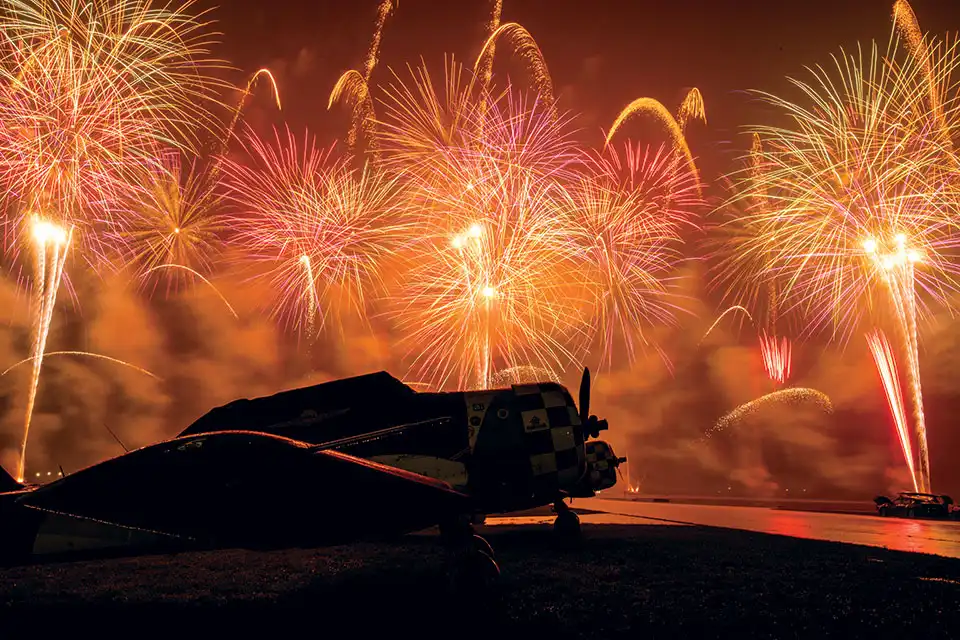The Big Bang
‘Scripted pyro musical’ brings elements of emotion into fireworks
By Barbara A. Schmitz
July 28, 2017 - What do you get when you choreograph music to a fireworks show? Certainly not your average Fourth of July display.
Dion Diehl, owner of DTG Pyrotechnics, has been doing fireworks on the EAA AirVenture Oshkosh grounds since 2010. But this isn’t just any fireworks show. Dion called it “a scripted pyro musical.”
“When you add music to a fireworks show, it allows you to bring elements of emotion into the fireworks,” he said. “It allows you to tell a story.”
This year’s story is about the 50th anniversary of the Apollo program, he said, and is meant to pay tribute to all those who worked tirelessly to put a man on the moon.
One of the unique fireworks in Saturday night’s show is a strobing rocket, which was custom-made for this AirVenture show. Another crowd-pleaser should be Japanese-style shells that are nothing short of gorgeous, Dion said.
Completing the night air show, the fireworks include five semitrailers full of shells, plus another 10 pods of shells spread out near show central. Dion said it takes 48-72 hours to get a show ready once they are on the grounds. And, it takes 3,697 shells and effects to light up the night skies at each show.
Dion uses a firing system, allowing him to control timing, position, and angle — and runs the script from his laptop. It took him 44 hours just to program the AirVenture show. “When you remember that we may be shooting 300-400 individual shells within 30 seconds, you can understand why it takes so much time,” he said.
But when you add in all the other things that need to be done — placing mortar racks and setting them on the appropriate angles on the semitrailers, pulling the shells from inventory and appropriately labeling them and then physically putting them in position and much, much more — it’s easy to see why it takes 31 people between 600-700 work hours to put on the two Oshkosh shows, he said.
About an hour before the show officially begins, the DTG crew begins setting up. “It’s like an orchestrated ballet when we roll out onto the field,” Dion said. “I’m the first vehicle leading a convoy of all the trailers and trucks, and I guide them into positions that are pre-marked,” he explained. The flatbed trailers are disconnected from the trucks, then employees ensure the communication wires are in place. From his laptop, he can see every single shell and tell whether or not it’s connected and ready to go.
Even after the show is over, their work isn’t done. Employees with flashlights walk in lines to ensure the runways are clean. They make sure everything that didn’t go off is disconnected. And, after Wednesday’s rain, crew members were also drying out their laptops and firing system. However, despite the rain, about 95 percent of the fireworks did fire, Dion estimated.
Not surprisingly, Dion said safety is always a huge priority.
“In our industry, when an error is made the implications are huge,” he said. “We always err on the side of caution.”
This means they are even stricter than national fire protection code guidelines, he said. So, if standards say they can shoot up to 8- and 10-inch diameter shells, the DTG crew shoots up to 6-inch diameter shells.
A big part of safety is about having qualified people work the show, Dion said. “All of us have daytime jobs, but the majority of the crew comes back each year. They drop everything for two weeks to make this happen.”
Dion got into this business because of his passion and need to light up the sky. “In reality, the sky represents so many things about reachable and unreachable dreams,” he said. “It gives us a moment to own something that is supposed to be out of reach.”

